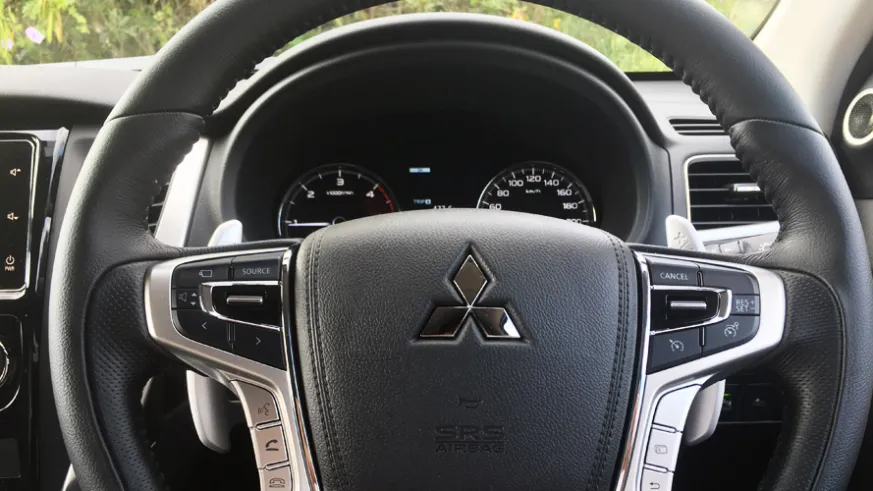
Review: 2016 Mitsubishi Pajero Sport Exceed
Posted in Vehicle Reviews
Review: 2016 Mitsubishi Pajero Sport Exceed
The Mitsubishi Pajero Sport is the new kid on the block, replacing the massively capable, but perennially unloved Challenger. Once again, it’s based off the Triton – but where the Challenger lived in the shadow of its trayback brother, Mitsubishi has made a real effort to refine the driving experience to differentiate the Pajero Sport.
We took the all-new Mitsi SUV to test out its capabilities on and off the road.

INITIAL IMPRESSION
The Pajero Sport looks completely overhauls the design of Mitsubishi’s dedicated medium SUV, with the front-end inspired by the new design found in the Triton and Outlander and a body that looks like a more athletic version of the Pajero, with angular lines to create an aggressive profile that matches its rivals.
At launch, the five seat Pajero Sport came standard with five seats across the range with a cavernous boot area. This stays the same on the GLX entry level models, however GLS and Exceed models were soon updated to include two extra seats as a third row as a no-cost option (it did seem a bit odd to have bottle holders in the boot...)
Other than the late addition of the extra 'plus-two' seating configuration, the Pajero Sport finds a niche in the market as a practical, stylish offroader for the family.

DRIVEABILITY
With the same 2.4-litre turbo-diesel underneath the hood that you’d find in the Triton, the Pajero Sport moves along at a good pace – especially with power up from the 2.5-litre found in the last Challenger. With 133kW of power and 430Nm of torque, the Pajero Sport is marginally less powerful on paper than its direct rivals, but in the real world is helped along by a brand first eight-speed auto changing the gears.
Out in the streets, the Pajero Sport is nimble hiding its two tonne weight well. There’s no pitch and roll when you’re trying to move at speed, and the retuned suspension behind the 18” alloy wheels is well tuned to soak up anything smaller than a boulder. Off-road the Mitsi is well-prepared with a version of the proven SuperSelect II 4WD system that can split torque between the wheels, and can be found in the bigger Pajero.
The eight-speed auto mentioned before is a first in a vehicle stamped with triple diamonds, and it is well suited to the Pajero Sport. The ratios are perfect for the power delivery; it never feels as though the engine is strained by a lack of forward gears. Stamping your foot down, though, won’t win you any drag races – rather, the turbo-diesels relatively short first gear is there to give you a smooth power curve instead of the usual ‘nothing-then-everything’ delivery found in diesel SUVs.

LIVEABILITY
The Pajero Sport is thrown into a segment that has become a cutthroat battleground for families shopping for their next vehicle. It's also refreshing to see that Mitsubishi responded to the diverse tastes of SUV buyers by offering a five seat and seven seat option.
While you do sacrifice the third-row seating in entry GLX models, the payoff for cargo space is immense. At one square metre between the wheel arches with the back seat in use, and close to two metres of length with the second row folded down, the Pajero Sport is built to carry anything you need. Even with the third row in use, the under floor storage tray increases the Pajero Sports practicality immensely.
In the Exceed, you can see that the Sport is built for comfort, and not just up front. The top-line model gets a DVD player and wireless headphones standard, along with Apple CarPlay/Android Auto compatibility and digital radio standard throughout the range on the Pajero Sport.
Around town, the Mitsi is easy to manoeuvre – though in Exceed trim, it is helped out immensely by driver assist features like Multi Around Monitor, which uses the cameras surrounding the Pajero Sport to give you a bird’s eye view of what’s happening. Indeed, the Sport is so dedicated to safety that the regular Mitsubishi emblem that sits on the grille doubles as a sensor.

The Exceed is the pick for buyers wanting the edge in safety, several class leading technologies are available in the Pajero Sport, but some – like the Ultrasonic misacceleration Mitigation System (UMS), which stops you from accelerating too quickly if there’s an object in front of you as well as forward crash mitigation, blind spot monitoring and lane departure warning.
The Pajero Sport is the perfect family buy then, especially if you’ve got three kids or less – because there are no compromises in terms of luggage space or drive. Being based on the new Triton, the Sport is setup to work smarter, rather than harder – able to offer a comfortable ride during times when you want a SUV, before switching the SuperSelect system on to get stuck into it on your holidays.
COST
The Pajero Sport range comes in entry level GLX for $45,000, mid-range GLS for $48,500 and the top level Exceed, as tested, for $52,750.
Recommended retail prices exclude on-road costs including dealer delivery, registration and stamp duty.
Options are limited to your colour choices with options of metallic and pearlescent paints, White is standard, while metallic Deep Bronze is only available on GLS and Exceed and pearlescent Black is only available on the Exceed. There are also a range of Genuine Accessories for the Pajero Sport, from floor mats to towbars and under body protection.
All Pajero Sports are covered by Mitsubishi’s Diamond Advantage, which provides for 5 years or 100,000km new vehicle warranty, 4 years of capped price servicing and 5 years of roadside assist.

CONCLUSION
Where the Challenger lived its life chasing rivals, the Pajero Sport jumps to the front of the pack. Mitsubishi have spent time crafting a product that fits into the now booming medium SUV category – thanks to the proliferation of the utes that underpin the majority of their architecture.
The new Pajero Sport may be a new entry, but it’s one of the better ones. Mitsubishi’s history of developing serious off-roaders and 4WDs is on full show, and it is clear that the new offering is here to win.



